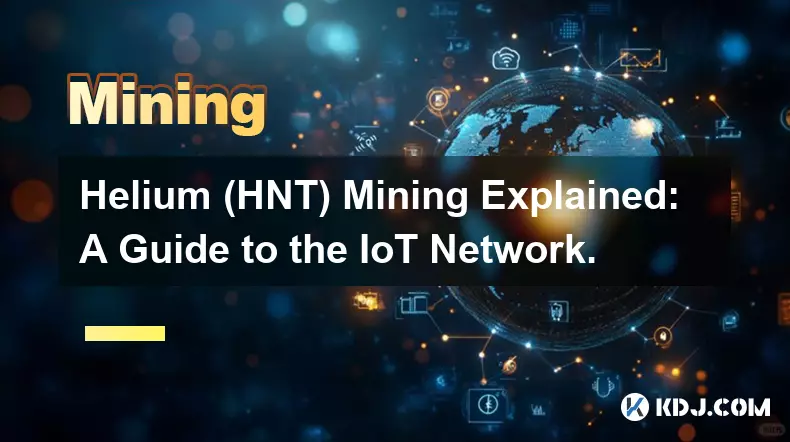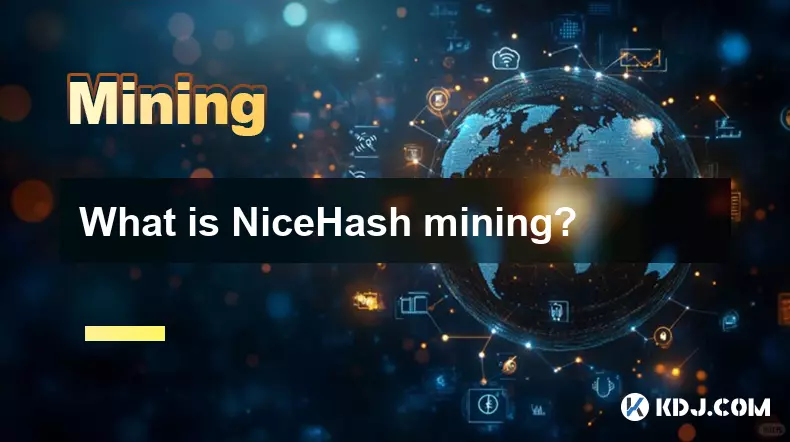-
 bitcoin
bitcoin $99177.955738 USD
-7.32% -
 ethereum
ethereum $3187.183061 USD
-12.38% -
 tether
tether $0.999809 USD
0.00% -
 xrp
xrp $2.117933 USD
-9.42% -
 bnb
bnb $906.710033 USD
-9.17% -
 solana
solana $149.367737 USD
-10.74% -
 usd-coin
usd-coin $0.999816 USD
0.01% -
 tron
tron $0.281498 USD
-0.38% -
 dogecoin
dogecoin $0.156292 USD
-8.00% -
 cardano
cardano $0.500744 USD
-10.19% -
 hyperliquid
hyperliquid $38.087358 USD
-4.58% -
 chainlink
chainlink $14.097831 USD
-8.54% -
 bitcoin-cash
bitcoin-cash $463.329916 USD
-9.22% -
 ethena-usde
ethena-usde $0.999078 USD
-0.01% -
 unus-sed-leo
unus-sed-leo $9.475862 USD
-0.79%
Helium (HNT) Mining Explained: A Guide to the IoT Network.
The Helium network uses decentralized hotspots to provide IoT connectivity, rewarding operators with HNT tokens for coverage and data transmission. (154 characters)
Nov 01, 2025 at 11:01 pm

Understanding the Helium Network and Its Purpose
1. The Helium network is a decentralized wireless infrastructure designed to support Internet of Things (IoT) devices. It leverages blockchain technology to create a peer-to-peer network where individuals can deploy hotspots to provide wireless coverage.
2. Instead of relying on traditional telecom providers, Helium uses LongFi, a proprietary protocol that combines LoRaWAN with blockchain-based consensus. This allows low-power devices to transmit data over long distances efficiently.
3. Participants in the network operate hardware known as Helium Hotspots. These devices act as wireless gateways, receiving data from IoT sensors and transmitting it to the internet via existing broadband connections.
4. To incentivize participation, the network rewards hotspot operators with HNT, the native cryptocurrency of the Helium blockchain. Rewards are distributed based on the quality and quantity of wireless coverage provided.
5. The entire system operates autonomously through smart contracts and cryptographic proofs, ensuring transparency and reducing reliance on centralized authorities.
How HNT Mining Works Differently Than Traditional Cryptocurrency Mining
1. Unlike Bitcoin or Ethereum mining, which relies on energy-intensive computational work, Helium mining is centered around real-world infrastructure deployment. Miners contribute by setting up physical hotspots rather than solving cryptographic puzzles.
2. Each hotspot participates in what's called 'Proof-of-Coverage' (PoC), a mechanism that verifies the legitimacy of wireless coverage. Hotspots send out test signals, known as beacons, which nearby devices witness and report back to the blockchain.
3. The frequency and reliability of these PoC challenges determine how much HNT a miner earns. Factors such as signal strength, geographic location, and network density influence reward distribution.
4. Data transfer also contributes to earnings. When IoT devices use a hotspot to send actual data, the operator receives additional HNT tokens proportional to the volume transmitted.
5. This model shifts the focus from raw computing power to tangible utility—providing connectivity becomes the primary means of value creation within the ecosystem.
The Role of HNT and Network Tokens in the Ecosystem
1. HNT serves as the foundational token of the Helium network. It is minted as a reward for miners and can be traded on various cryptocurrency exchanges.
2. A portion of newly minted HNT is converted into Data Credits (DC), a non-transferable token used to pay for data transmission on the network. Users burn HNT to generate DC, creating constant demand for the base token.
3. Because Data Credits are required for any device to communicate over the network, this mechanism ensures that HNT maintains intrinsic utility beyond speculative trading.
4. The dual-token system separates governance and usage: HNT holders may participate in future upgrades and decisions, while DC handles operational costs without volatility concerns.
5. This design fosters a self-sustaining economy where supply, demand, and network growth are tightly interlinked through practical application.
Challenges and Considerations for Aspiring Helium Miners
1. Profitability depends heavily on location. Urban areas with high IoT activity and sparse hotspot competition tend to yield better returns due to higher data transfer volumes and more frequent PoC rewards.
2. Initial investment includes purchasing a compatible hotspot, which ranges from $200 to over $500 depending on performance and brand. Some models integrate antennas and modems, while others require external components.
3. Internet stability and placement matter significantly. Hotspots need consistent broadband access and optimal antenna positioning—ideally near windows or elevated locations—to maximize signal reach.
4. Regulatory compliance should not be overlooked. Operating radio transmitters may require adherence to local telecommunications laws, especially regarding frequency usage and emission standards.
5. Network saturation in certain regions has led to diminishing returns, prompting many miners to explore alternative Helium-based networks like Mobile (5G) or LoRaWAN expansions.
Frequently Asked Questions
What equipment do I need to start mining HNT?You need a Helium-compatible hotspot, a reliable internet connection, and sufficient power supply. Most hotspots connect via Ethernet or Wi-Fi and must remain online to earn rewards continuously.
Can I run multiple hotspots at the same location?Yes, but earnings may not scale linearly. The network applies density controls to prevent spam; closely placed hotspots often receive reduced rewards unless they serve distinct geographic zones.
Is HNT mining still profitable in 2024?Profitability varies by region and setup cost. In underserved areas with growing IoT adoption, returns can be strong. However, oversaturated markets may offer limited income, requiring careful analysis before investment.
How are HNT rewards distributed?Rewards are issued daily and deposited directly into your Helium wallet. They consist of both Proof-of-Coverage participation and data transfer incentives, calculated automatically by the blockchain.
Disclaimer:info@kdj.com
The information provided is not trading advice. kdj.com does not assume any responsibility for any investments made based on the information provided in this article. Cryptocurrencies are highly volatile and it is highly recommended that you invest with caution after thorough research!
If you believe that the content used on this website infringes your copyright, please contact us immediately (info@kdj.com) and we will delete it promptly.
- PumpFun, Solana, Price Prediction: Riding the Solana Wave
- 2025-11-06 07:20:01
- Bitcoin Treasury Takes Root in Europe: Institutional Platforms Emerge
- 2025-11-06 07:45:01
- Lido & Chainlink CCIP: wstETH Transfers Get a Major Upgrade
- 2025-11-06 07:30:01
- Zcash (ZEC) Price Breakout: Privacy's Comeback Kid?
- 2025-11-06 07:50:01
- MSTR Sinks as Bitcoin Declines: A 25% Drop Deep Dive
- 2025-11-06 07:50:01
- Trump, Crypto, and Solana: Decoding the Intersections in the Concrete Jungle
- 2025-11-06 07:00:01
Related knowledge

What is the block reward in mining?
Nov 06,2025 at 12:35am
Understanding Block Rewards in Cryptocurrency Mining1. The block reward is the incentive miners receive for successfully validating and adding a new b...

How do mining algorithms work?
Nov 06,2025 at 04:59am
Mining Algorithms and Their Role in Blockchain Networks1. Mining algorithms serve as the backbone of blockchain consensus mechanisms, ensuring that tr...

What is NiceHash mining?
Nov 06,2025 at 07:40am
NiceHash mining refers to the process of renting out computational power to individuals or organizations seeking to mine cryptocurrencies without owni...

Does an antivirus program affect mining?
Nov 05,2025 at 09:29pm
Understanding Decentralized Exchanges in the Crypto Ecosystem1. Decentralized exchanges (DEXs) operate without a central authority, allowing users to ...

What is the history of Bitcoin mining?
Nov 05,2025 at 08:15pm
Within the fast-moving world of cryptocurrency, new developments emerge daily, reshaping how investors, developers, and institutions interact with dig...

How is the energy consumption of mining justified?
Nov 05,2025 at 10:20pm
Energy Consumption in Cryptocurrency Mining1. The energy consumption associated with cryptocurrency mining has drawn significant attention from enviro...

What is the block reward in mining?
Nov 06,2025 at 12:35am
Understanding Block Rewards in Cryptocurrency Mining1. The block reward is the incentive miners receive for successfully validating and adding a new b...

How do mining algorithms work?
Nov 06,2025 at 04:59am
Mining Algorithms and Their Role in Blockchain Networks1. Mining algorithms serve as the backbone of blockchain consensus mechanisms, ensuring that tr...

What is NiceHash mining?
Nov 06,2025 at 07:40am
NiceHash mining refers to the process of renting out computational power to individuals or organizations seeking to mine cryptocurrencies without owni...

Does an antivirus program affect mining?
Nov 05,2025 at 09:29pm
Understanding Decentralized Exchanges in the Crypto Ecosystem1. Decentralized exchanges (DEXs) operate without a central authority, allowing users to ...

What is the history of Bitcoin mining?
Nov 05,2025 at 08:15pm
Within the fast-moving world of cryptocurrency, new developments emerge daily, reshaping how investors, developers, and institutions interact with dig...

How is the energy consumption of mining justified?
Nov 05,2025 at 10:20pm
Energy Consumption in Cryptocurrency Mining1. The energy consumption associated with cryptocurrency mining has drawn significant attention from enviro...
See all articles










































































